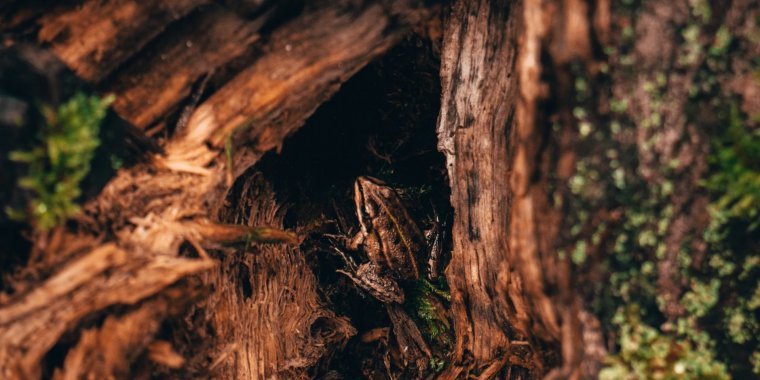| News / Science News |
Toads surprise scientists by climbing trees in UK woodlands
Until now, common toads were thought to be terrestrial. The highest toad in this study was found three metres up a tree – and scientists say there is a chance the toads might be venturing even higher.

Toad in a tree. Photo: Obscure Space/Unsplash
The surprising discovery was made during a survey to search for hazel dormice and bats as part of the National Dormouse Monitoring Programme and the Bat Tree Habitat Key project.
The research was led by the University of Cambridge and Froglife, and supported by wildlife charity People’s Trust for Endangered Species (PTES).
Dr Silviu Petrovan, Senior Researcher at the University of Cambridge and Trustee at Froglife, and first author of the study, said: “This is a really exciting finding, and significant for our understanding of the ecology and conservation of common toads - one of the most widespread and abundant European amphibians.”
He added: “We know common toads favour woodlands as foraging and wintering habitat, but it appears their association with trees is much more complex than we had previously thought.”
Common toads are regarded as typical terrestrial amphibians, which spend their time both on land and in water during breeding. To date there have only been a handful of documented sightings of common toads in trees in the UK.
Consequently, common toads and UK amphibians in general have never been surveyed for in trees, unlike bat and dormouse surveys - which specifically target this habitat.
The study highlights the importance of sharing data between conservation organisations representing different species, and shows that there is a lot to learn about wildlife in the UK – even about species believed to be well-known.
Nida Al-Fulaij, Conservation Research Manager at PTES said: “We couldn’t believe what we found. We’re used to discovering woodland birds and other small mammals in nest boxes but we hadn’t considered finding amphibians in them.”
Over 50 common toads were found during surveys of hazel dormouse nest boxes (located 1.5m above ground) and tree cavities usually used by bats.
Many of the cavities were small or not visible from the ground, so it is unclear how toads are finding them and how difficult it is for toads to climb particular trees.
Toads were not found in boxes or tree holes with other species, however they were found using old nests made by dormice and even birds.
While 50 records is not a huge number, it is comparable to records of other animals known to use trees regularly - such as blue tits.
This suggests that toads spend more time in trees than was previously thought.
If this is true, it means that common toads could be found in up to one in every hundred trees in the UK in particularly favourable areas, such as near large ponds or lakes.
The discovery suggests that tree cavities might represent an even more important ecological feature than conservationists previously thought.
It highlights the importance of protecting our remaining natural woodland habitats, especially ancient trees with veteran features (such as hollows, cracks and other natural cavities) for all wildlife.
It is not currently known why toads are climbing trees and using nest boxes. Factors could include searching for food, avoiding predators or evading parasites such as toad fly. (University of Cambridge)
YOU MAY ALSO LIKE





